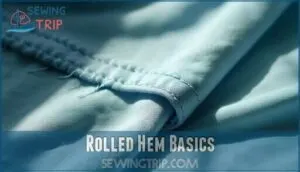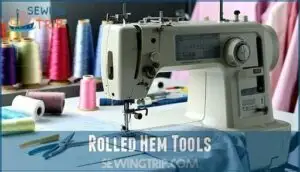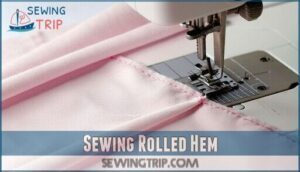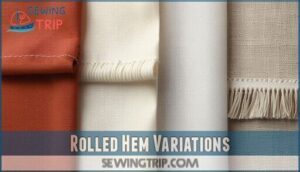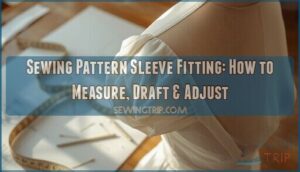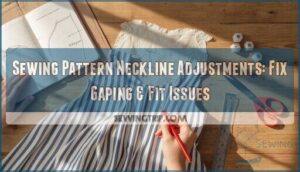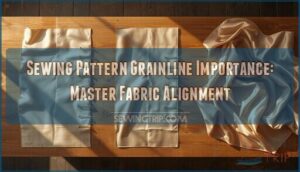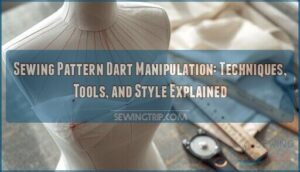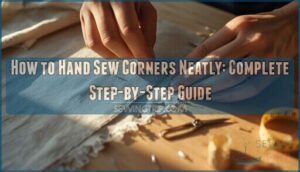This site is supported by our readers. We may earn a commission, at no cost to you, if you purchase through links.
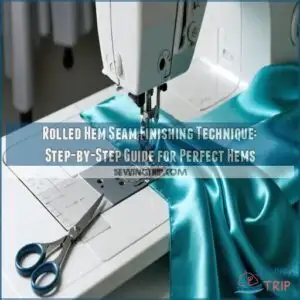
You’ll need a sewing machine with a rolled hem foot, though a serger works for a polished finish too. Start by folding the edge twice—just a sliver—and sew it tightly, letting the foot guide the fabric.
Patience is key, especially with delicate textiles that tend to misbehave. This method works wonders for scarves, hems, and ruffles.
Mastering it takes practice, but it’ll elevate any project with a crisp, refined look.
Table Of Contents
Key Takeaways
- You can easily create a clean, professional edge on lightweight fabrics using a rolled hem foot or serger.
- Patience is key—adjust your sewing machine’s tension, stitch length, and use sharp needles to avoid puckering.
- For delicate fabrics, stabilize with a water-soluble layer and test on scraps before starting your project.
- A rolled hem works great for scarves, ruffles, and dress details, adding a polished touch without bulk.
Rolled Hem Basics
A rolled hem is a precise seam finishing technique that wraps the raw edge of your fabric into a tiny, clean fold.
It works best on lightweight to medium fabrics, giving garments like dresses and ruffles a polished, professional look.
Definition and Purpose
A rolled hem is a hemming technique that folds and stitches fabric’s edge tightly, creating a clean, professional seam finish.
Achieve a clean, professional finish by tightly folding and stitching fabric edges with the effortless elegance of a rolled hem.
It encloses seam allowances inside the hem, preventing fraying and adding durability.
This hem definition showcases its purpose: achieving a polished, lightweight edge, and it’s a go-to for delicate fabrics requiring precise, functional edge finishing without bulk, making it a technique for a delicate fabrics.
Suitable Fabrics
For light to medium-weight fabrics, a rolled hem works wonders, offering a polished finish.
Opt for sheer fabrics, silks, and similar delicate types for best results. Avoid heavy options that create bulk.
Pairing fabric drape with fray-resistant edges guarantees success. A serger is useful, but a twin needle alternative can also work.
Here’s what to keep in mind:
- Sheer fabrics like chiffon
- Silks for elegance
- Lightweight knit fabrics
- Finely woven linen
- Soft cotton voile
Common Applications
Ideal for adding finesse to your projects, rolled hems are perfect for light to medium-weight fabrics.
Use this versatile technique for skirt hems or dress details. It also enhances top finishes and ruffle edges, making lingerie garments or occasion wear look polished.
Below is a quick guide to common applications:
| Application | Fabric Type | Examples | Benefits |
|---|---|---|---|
| Skirt Hems | Sheer fabrics | Chiffon skirts | Lightweight, elegant finish |
| Dress Details | Light silks | Formal dresses | Neat, invisible hem |
| Ruffle Edges | Medium-weight fabrics | Decorative cuffs | Flowy, professional effect |
| Bodice Accents | Delicate fabrics | Evening gowns | Refined, polished look |
The rolled hem technique is suitable for various applications, including skirt hems, dress details, ruffle edges, and bodice accents, each providing a unique benefit such as a lightweight and elegant finish.
Rolled Hem Tools
To achieve a clean and polished rolled hem, you’ll need the right tools to guarantee precision and ease.
A dependable sewing machine, an optional rolled hem foot, and even a serger can substantially enhance your results.
Sewing Machine Requirements
To create flawless rolled hems, start with a sewing machine that’s compatible with fine fabrics.
Master rolled hems with a sewing machine tailored for fine fabrics—precision and finesse ensure a polished, professional finish every time.
Fine-tune these four areas:
- Needle Selection: Use sharp needles for precision.
- Stitch Settings: Shorten lengths for cleaner edges.
- Tension Adjustment: Balance tension to avoid puckering.
- Foot Installation: Install a universal foot if specialized tools aren’t available.
To guarantee longevity, lubricate gears periodically for smooth operation.
Master your sewing machine techniques!
Rolled Hem Foot Options
A rolled hem foot simplifies sewing hems by folding fabric edges neatly before stitching.
Choose from narrow, wide, or specialty feet suited to your fabric. Adjustable feet offer flexibility, while snap-on options fit most machines.
These specialized tools are available for purchase online.
Troubleshooting? Practice is key—start slow, as fabrics can slip. Explore online rolled hem tutorials to master this versatile tool for polished finishes.
Serger Usage
A serger simplifies finishing hems with its precise serger rolled hem option.
Adjust serger settings, including tension adjustments and differential feed, for smooth edges, especially on curved hems.
Overlockers handle lightweight fabrics beautifully but require routine serger maintenance.
Explore serger rolled hem options for your projects.
Testing settings prevents skipped stitches or puckering, and customize each project by fine-tuning serger settings, ensuring consistent results and a professional, polished finish with smooth edges.
Sewing Rolled Hem
Creating a rolled hem may seem intricate, but it’s a straightforward process with the right preparation.
By carefully folding, pressing, and stitching, you’ll achieve a clean, professional finish suitable for lightweight fabrics.
Step-by-Step Process
Ever wondered how to master the perfect rolled hem? Start by properly preparing your seam and using a sewing machine with precise stitch length.
- Sew 1/4" from the hem edge for stitching accuracy.
- Trim excess fabric close to stitches.
- Fold fabric to conceal the edge.
- Secure with a second stitch line.
Follow this sewing tutorial for a neat finish. Many resources are available if you need a rolled hem guide, especially to learn the basics of sewing.
Pressing and Folding Techniques
Mastering pressing and folding is key to precise rolled hem sewing.
Start by pressing the seam allowances flat to meld stitches into the fabric. Use accurate folding to roll the hem allowance evenly, showing only a tiny edge.
Proper ironing techniques help maintain shape, even with curved hems. Careful fabric manipulation prevents uneven edges, ensuring a polished finish.
Securing The Hem
To secure your rolled hem, sew directly on the previous stitching line for accuracy and a professional finish.
Backstitching adds stability at the start and end.
Trim excess fabric close to the seam, fold once more, and stitch again.
This technique hides edges and leaves neat stitching lines.
Using a rolled hem foot can guarantee a clean finish.
It’s the secret to a sleek hem finish!
Rolled Hem Variations
You can experiment with rolled hem variations to achieve different looks and finishes customized to your project.
From narrow hems for lightweight fabrics to fringed edges for decorative accents, each option adds its own unique touch.
Narrow Rolled Hem
A narrow rolled hem, often called pin hemming, is perfect for sheer fabrics and lightweight projects.
It delivers fine details and a sleek hem finish on light to medium-weight fabrics.
Sew with precision, folding fabric edges twice before stitching, this decorative finish adds a polished seam finish, ideal for airy garments where bulkless elegance matters.
Accuracy guarantees a flawless appearance.
Couture Rolled Hem
A couture rolled hem offers heirloom quality and customization options, making it perfect for luxury fabrics like silk or chiffon.
You’ll love how invisible stitches create a seamless, handstitched hem.
Follow these steps:
- Fold and press the edge of the fabric neatly.
- Use tiny, precise stitches to roll the hem.
- Press gently for a professional hem finish.
Baby Hem and Fringed Hem
If you’re tackling lightweight, fray-prone fabrics, a baby hem guarantees durability and professional edge control.
It’s a narrower version of a rolled hem, offering subtle charm.
A fringed hem, however, adds decorative options, turning straight edges into standout features.
Both methods enhance seam finish and provide creative project ideas, guaranteeing your sewing techniques work harmoniously with fabric suitability.
Advanced Rolled Hem Techniques
You can elevate your rolled hems with advanced techniques like using contrasting thread, managing delicate fabrics, or combining methods for a custom finish.
These approaches require focus and precision but result in hems that look professional and unique.
Contrasting Thread Colors
For a creative twist, use contrasting thread in your rolled hem for a bold color pop or subtle contrasts.
This decorative hemming technique adds personality to garments, especially sheers.
Create an exposed ruffle effect by pairing striking thread with delicate fabrics.
It’s a simple yet impactful seam finish, proving that sewing techniques can be both functional and stylish.
Working With Delicate Fabrics
How do you perfect a rolled hem on delicate fabrics? Start with lightweight silk and choose the right needle—microtex needles work best.
Adjust your sewing machine tension to avoid puckering. Use a water-soluble stabilizer for extra fabric grip and prevent snags.
Selecting gentle detergents is vital for maintaining the fabric’s integrity. Test stitches on scraps to refine your seam finish.
Patience guarantees flawless results on sheer fabrics!
Combining With Other Finishing Techniques
Blending rolled hems with other sewing techniques elevates your seam finishing.
Pair it with these methods for polished results:
- Seam Grading: Trim seam allowances for reduced bulk.
- Faced Hems: Add structure to curved edges.
- Hong Kong Finish: Cover raw edges with bias tape.
- Flat Felled Seams: Strengthen visible seams.
- Slot Seams: Add decorative accents.
Stay creative!
Frequently Asked Questions (FAQs)
What is an alternative to a rolled hem?
You can try a baby hem or a narrow machined hem.
Both offer neat finishes without bulk, especially for lightweight fabrics.
Hand-stitched hems are another option, giving an invisible, polished look for woven materials.
How to troubleshoot uneven rolled hem stitching?
80% of uneven rolled hems come from incorrect tension or uneven feeding.
Check your thread tension, make certain your fabric feeds smoothly, and press your hem evenly beforehand.
Use stabilizers for slippery fabrics and adjust stitch length.
Can rolled hems work effectively on curved edges?
Yes, rolled hems can work on curved edges, but you’ll need patience.
Trim evenly, use a stabilizer for control, and stitch slowly.
Pressing each step guarantees a smooth finish without puckering or distortion.
What thread types are best for rolled hems?
Think silk versus denim—lightweight polyester or silk threads are perfect for delicate rolled hems, while heavier threads add unnecessary bulk.
Opt for matching thread colors to blend seamlessly, or contrast for a decorative edge.
How to avoid puckering on lightweight fabrics?
Use a smaller stitch length, stabilize fabric with tissue paper or water-soluble stabilizer, and evenly guide through the machine.
Maintain consistent tension, use fine thread, and make certain the needle is sharp to prevent puckering.
Are specific needles recommended for rolled hems?
For rolled hems, use a size 70/10 or 80/12 universal needle for most lightweight fabrics. For delicate options like silk, switch to a microtex needle for precise stitching and reduced fabric damage.
Conclusion
Mastering the rolled hem seam finishing technique is like perfecting the final brushstroke on a painting—it transforms your project into a polished masterpiece.
With the right tools, steady hands, and patience, you can achieve crisp, professional edges on delicate fabrics.
Whether you’re hemming a scarf or creating elegant ruffles, this method adds sophistication to any design.
Practice guarantees precision, so don’t rush the process.
Let this guide inspire your next sewing project with refined, seamless results.

